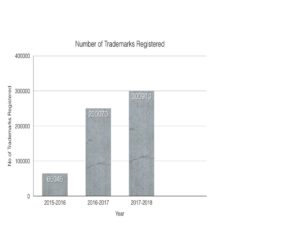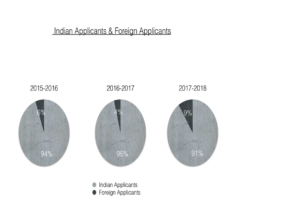INTRODUCTION
In the modern globalised economy, INTELLECTUAL PROPERTY is one of the integral parts, which covers copyright, Trademark, Design, Geographical indications, Patent, Industrial designs, etc.
Intellectual property registration and protection is essential to guard invention. In case no legal protection is provided to such creative innovations, then the individual would not be able to reap the full benefits of their inventions and creativity would suffer as a result.
Trademark, one of the branches of IP is a mark or symbol which differentiate the goods or services of one proprietor from that of another. In short trademark signifies the brand, name, with which are associated the goodwill and reputation of proprietor business. This makes Trademark registration an important part of IP.
In INDIA the trademark registration is looked after by CONTROLLER GENERAL OF PATENTS DESIGNS TRADEMARKS, MINISTRY OF COMMERCE AND INDUSTRY, GOVERNMENT OF INDIA. Government has taken every possible step to simplify the procedure of registration for trademark . Recently the controller general office has released its annual report for 2017-2018 which highlight the extent of activities undertaken by office.

The report shows that No. of application file with the office of the registration of Trademark have decreased marginally from 278170 to 272974 (2017-2018). However, an important point to be mentioned here is that the no. of trademark registered by the controller general’s office has increased substantially from 65045 in 2015-2016, to 250070 in 2016-2017, to 3000913 in 2017-2018. Potential reason for increase is the signified registration and speedy disposal by the CONTROLLER GENERAL’S OFFICE.

This simplified procedure for registration has simultaneously resulted in an increase in the foreign applications, from 11440 in 2016-2017 to 25307 in 2017-2017, almost double. Out of the total foreign applications 13475 have been filed through Madrid System , which is a primary international system for facilitating the registration of Trademarks in multiple jurisdiction around the world .Among the Indian applications, most are from the state of Maharashtra , with 63070 applications in total . The field of Advertising, Business management Business Administration office functions have witnessed maximum applications, with 26467 applications out of total 272974 applications, while the minimum have been registered for musical instruments other than talking machines and wireless apparatus, accounting for only 250 applications.

There are five branches of CONTROLLER GENERAL’S office including the head office at MUMBAI. The maximum applications have been filed at Delhi branch and minimum at Kolkata branch. As far as the number of Trademark registered are concerned, maximum have been in the field of medical , pharmaceuticals , veterinary and sanitary substances etc. with a total of 43371 trademark being registered while the minimum registration has been witnessed by musical instrument (other than talking machines and wireless apparatus) with as low as 545 mark being registered.
From the registration fees being deposited by the applicants, the controller general’s office has generated a revenue of 286.11 cr. in 2017-2018, which is comparatively higher to the revenue of 192.36 cr. generated in 2016-2017. The no. of Trademarks published in the journal have increased from 67796 in 2013-2014 to 423030 in (2017-2018). The no. of trademarks registered have increased from 67796 in 2013-2014 to 300913 in (2017-2018).
CONCLUSION
Controller General’s office not only looks after the registration of Trademark, but also review the application for renewal of trademark, scrutinizes the opposition filed by any third party against the trademark published in the journal and settle down the dispute related to the trademark registration if there is any . Thus the office of Controller General is the most important office dealing with all this issues related to not only Trademark but every other branch of Intellectual Property. 
